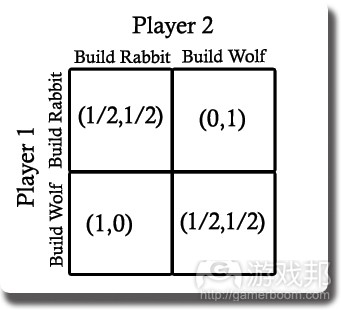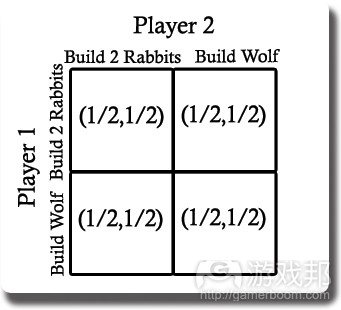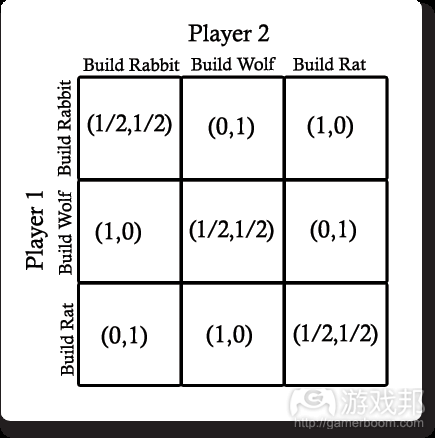解析可运用于游戏设计中的平衡理论
作者:John Graham
每款现代即时游戏都包含某些形式的石头、剪子、布机制。玩家潜意识中知道此类机制的存在,而且它们运转良好,但是没有人解释其中的缘由。通过些许游戏理论,我能够向你澄清其中的原因。但是首先,我需要先给你提供些许简单的游戏理论定义。
何为游戏?
游戏是个保量两个或更多玩家的框架,每个玩家的胜利不仅取决于自己的战略,还取决于游戏中其他玩家所采取的战略。
何为战略?
战略是玩家解释自己将在游戏中如何表现的完整动作计划。
何为优势战略?
优势战略指在所有情境中与所有其他战略效果相同,但在至少1种情境下优于其他所有战略的特殊战略(游戏邦注:比如在含有石头、布和散弹枪的游戏中,散弹枪就是优势战略)。
获得胜利的方法
让我们以电脑游戏为例来解释上述内容。假设两个玩家正在玩名为《Lugaru Wars》的RTS游戏。每个玩家拥有的资源只够制造1只狼或1只兔子。假设游戏胜利者可以获得1分。同时,假设狼总是能够打败兔子。最后,我们假设狼与郎,或兔子与兔子之间战斗的胜率各方均为50%。下图显示游戏的情况:
结果以(X,Y)的形式呈现,X代表玩家1获胜的几率,Y代表玩家2获胜的几率。
从结果模型中可以看出,很显然制造狼是种优势战略。如果我的对手制造兔子,而我制造的是狼,那么我就能够获得1分,但我制造兔子只能获得1/2分。如果我的对手制造了狼,而我制造的是兔子,那么我无法得分,而我制造狼可以得到1/2分。无论出现何种情况,选择制造狼的结果总是比较好。这个游戏的设计不平衡,因为任何想要赢的玩家都会一直制造狼,而兔子永远都不会在游戏中出现。当每个玩家都制造狼时,游戏就会发生“纳什均衡”(纳什均衡指的是这样一种战略组合,这种策略组合由所有参与人的最优策略组成。即在给定别人策略的情况下,没有人有足够理由打破这种均衡)。
平衡但乏味
这种情况要如何弥补呢?假设狼的力量是兔子的两倍,那么当2只兔子遇上1只狼时,获胜的几率也会是50%。那么,平衡这款RTS的最快方法是让制造兔子所耗费的资源变成狼的一半。那么现在,使用同样的资源,玩家可以选择制造1只狼或2只兔子。这样,结果模型如下图所示:
在这样的游戏中,制造2只兔子的战略和制造1只狼的战略效力相同。有人会辩解说,经过这样的修改,兔子也会在游戏中出现,我们的目标实现了。但是,这样的游戏仍然很乏味无趣,因为玩家完全无需考虑自己要制造什么和对手可能制造什么。每个人都会想:只要我花费所有资源来制造单位,无论制造什么胜率都是50%。
融合
以上两个都是乏味无聊的例子。让我们通过添加新的角色来让游戏变得更加有趣。假设玩家依然只能选择制造1个单位,但是现在他们的选项有3个:老鼠、狼和兔子。在这款游戏中,我们假设狼可以打败兔子,但是老鼠足够狡猾,可以伏击并打败狼。最后,假设兔子有敏锐的听觉,可以揪出潜伏的老鼠并将其打败。那么,这款游戏的结果模型就如下图所示:
现在,游戏就不再有优势单位,而且每个玩家都会想知道其他玩家做出何种选择,这样他们才能选择能够战胜对手的单位。游戏再次实现平衡(游戏邦注:每个单位在游戏中都有优势),而且不存在明显的优势战略。在这样的平衡游戏中,不存在纯粹的战略“纳什平衡”,只存在利弊共存的策略性“纳什平衡”,玩家选择任何单位的可能性都是相同的。
如果你想要向玩家提供超级战略,可以设置超级战略需要消耗玩家一定比例的能量,这样他们就无法频繁执行超级战略。更为重要的是,确保游戏中没有在所有情境中通用的超级战略。游戏设计师的任务就是要通过结合弱势来对抗优势,这样玩家就不会一次次地重复使用相同的优势战略,他会发现在某些情境下自己必须采用新的战略。
我如此喜欢《复仇格斗兔》的原因之一是,它不仅没有优势战略,而且还通过AI来惩罚那些重复使用一种攻击方式的玩家。因而,玩家被迫试验不同的战略,并且习惯于在游戏中使用多种战略。
游戏邦注:本文发稿于2009年1月24日,所涉时间、事件和数据均以此为准。(本文为游戏邦/gamerboom.com编译,拒绝任何不保留版权的转载,如需转载请联系:游戏邦)
Game Theory Applied To Game Design
John Graham
Every modern real-time game has some form of rock, paper, scissor mechanics. As gamers we subconsciously know that such mechanics are there and that they work pretty well but no one ever explains why. With a little bit of game theory I can show you why but first I’ll need to give you some brief game theory definitions.
What is a game?
A game is a framework involving two or more players where each player’s success is determined not only by his own strategy, but by the strategies of all the other players in the game.
What is a strategy?
A strategy is a complete plan of action for a player that explains how he will behave.
What is a dominant strategy?
A dominant strategy is a strategy that does at least as well as every other strategy in all situations but does strictly better than every other strategy in at least one situation. (In a game of rock, paper, shotgun, the shotgun would probably be the dominant strategy.)
One Way To Win
Let’s stitch this together in a computer game example. Let’s say there are 2 people playing an RTS called Lugaru Wars. Each player has just enough resources to either make one wolf unit or one rabbit unit. Let’s assume that winning the game earns the winner one point. Let’s also assume that wolves always beat rabbits (the rabbits are not like Turner). Finally let’s assume that the result of a wolf fighting a wolf or a rabbit fighting a rabbit is a 50/50 toss up where each player’s expected winnings are half a point. Here’s what the game would look like in normal form:
Payoffs are represented in the form (X,Y) where X is what Player 1 has won and Y is the winnings for Player 2. For more information on how to read and understand normal form games click here.
From looking at the payoff matrix, it becomes clear that building a wolf is the strictly dominant strategy. If my opponent builds a rabbit and I counter with a wolf, I get 1 point whereas countering with a rabbit gives me an expected value of 1/2. If my opponent builds a wolf and I counter with a rabbit I am guaranteed to lose and get 0 points whereas countering with a wolf, I can expect 1/2. Choosing to build a wolf makes me better off in every scenario. This game is not balanced because any player who is trying to win, builds the wolf unit all the time every time and the rabbits might as well not be in the game at all. (Bonus Fact: the “Nash Equilibrium” of this game occurs when each player builds a wolf.)
Balanced But Boring
How can this be fixed? Let’s pretend that wolves are twice as powerful as rabbits, so that when two rabbits meet one wolf, it’s a 50/50 toss up as to who will win. A quick fix for balancing this RTS is to make the rabbit cost half as many resource points as the wolf. So now with the same resources each player can build either one wolf or two rabbits. Now the payoff matrix looks like this:
In this game the strategy of building 2 rabbits is just as effective as building one wolf. One could try to argue that our work is done and we will now see a healthy mix of both units being built. However, this game is still very boring because the players don’t care at all what they build or what their opponent builds. Each person says, “Hey as long as I spend all my resources building something, I can always expect half a point no matter what.”
Mixing It Up
Ok, enough boring examples. Let’s spice this up by adding another character. Let’s say that players can again only build one unit each but now they can choose among a rat, a wolf and a rabbit. In this game assume wolves always beat rabbits but rats are sneaky enough that they can always ambush and kill wolves. Finally, the rabbits have such good hearing that the rats can not sneak up on them and rabbits can destroy rats every time. Here’s what the game’s payoffs would look like:
Now is there one dominant unit type that is always the best to build? No. Do players still feel indifferent about what they build relative to what their opponent is building? No, quite the opposite. Now each player really wants to know what the other player is up to so that he can build the right counter unit. The game is again balanced (each unit has equal merit) but there is no obvious strategy. (Bonus Fact: This balance here coincides with the fact that there is no pure strategy Nash Equilibrium in this game, only a mixed strategy Nash Equilibrium where both players are equally likely to pick any of the three units).
If you’re going to allow the player a super-strategy, make its cost to the player proportional to its power so they can’t execute it frequently. More importantly, make sure that the player can’t derive a super-strategy that works in every situation. Game designers have an obligation to combine some weaknesses with the strengths for a given course of action so that instead of dooming the player to repeat his same old dominant strategy again and again he finds himself forced into situations where a new strategy must be derived.
One of the reasons I like Lugaru so much is that not only is it structured to have no dominant strategy, no move to beat all moves, but David actually programmed the AI to punish users that repeat one type of attack too many times in a row. Players are thus forced to experiment and become comfortable with a lot of different moves.
Can you think of any games that are famous for embracing mixed strategies with their careful balance? Do you have any thoughts on how to take these game design concepts further? (Source: Wolfire Blog)
上一篇:论述风险元素在游戏设计中的重要性











































